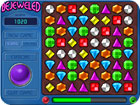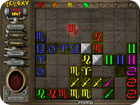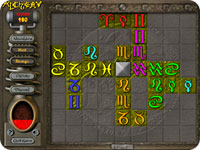Best Played With a Cup of Coffee
By Brad Cook
When you need to take a quick break from work, revitalize your brain with a puzzle game. Tetris was one of the first games to provide such relief to people who log a lot of time in front of their Macs, and PopCap Games continues that tradition with the release of Bejeweled & Alchemy, which offers both games on the same CD.
Alchemy features a twist on the ancient art of turning lead into gold. You place mystical runes on a playing field one at a time, turning each lead block into gold. You can only place runes next to each other if their color and/or shape matches, however, which makes their placement tricky as the board fills up. If you fill a row or column with runes, all of them vanish. Once you turn all the lead into gold, you move to the next level, which adds new kinds of runes for more complex gameplay.
You have a few weapons on your side, though. Every so often you’ll get a spinning skull, which destroys any rune on the board, or a gray stone, which you can place next to any rune, to help you out of tricky spots. And any time you’d rather get rid of a rune than place it on the board, you can toss it in the forge, which will fill a little; throw away four runes and the forge will bubble over, ending your game (every piece you place on the board cools the forge a bit, though). Don’t forget that you’ll be forced to discard any rune that won’t fit on the playing field.
Alchemy offers three difficulty levels as well as a time trial mode in which the forge fills as you play; the goal is to keep placing runes on the board, cooling the forge off with each one. As before, the game ends when the forge fills completely.
A Shining Example of a Great Game
In Bejeweled, you swap two adjacent jewels and form a row or column of three or more jewels that are exactly alike. They’ll vanish and the ones above them will drop down; if that action forms more rows or columns of like jewels, they’ll vanish too, possibly producing even more matches (this is called a cascade). Each match fills the bar at the bottom of the screen a little bit; when it fills completely, you move to the next level. If you run out of possible moves, the game is over.
Like Alchemy, Bejeweled also features a time trial mode. It challenges you to keep the bar at the bottom of the screen from depleting. Every match you produce fills the bar more; if you pull off cascades, you’ll fit it a lot. When it fills completely, you move to the next level.
Both games also save your game in progress when you quit, which is perfect when you need to get back to work.


Bejeweled & Alchemy: This set of addictive distractions will help you escape reality for a few welcome moments.
| Game Media | ||||
|
||||
System Requirements:
| Mac OS X version 10.1 or higher |
|
| 233MHz PowerPC G3 processor or better |
|
| 128MB of RAM |
 Both games feature hint buttons that will help you when you click on them, but you’ll lose points in the process (in the time trials, hints push you closer to losing). So we’ve assembled a few tips that will make you a Bejeweled & Alchemy expert.
Both games feature hint buttons that will help you when you click on them, but you’ll lose points in the process (in the time trials, hints push you closer to losing). So we’ve assembled a few tips that will make you a Bejeweled & Alchemy expert.